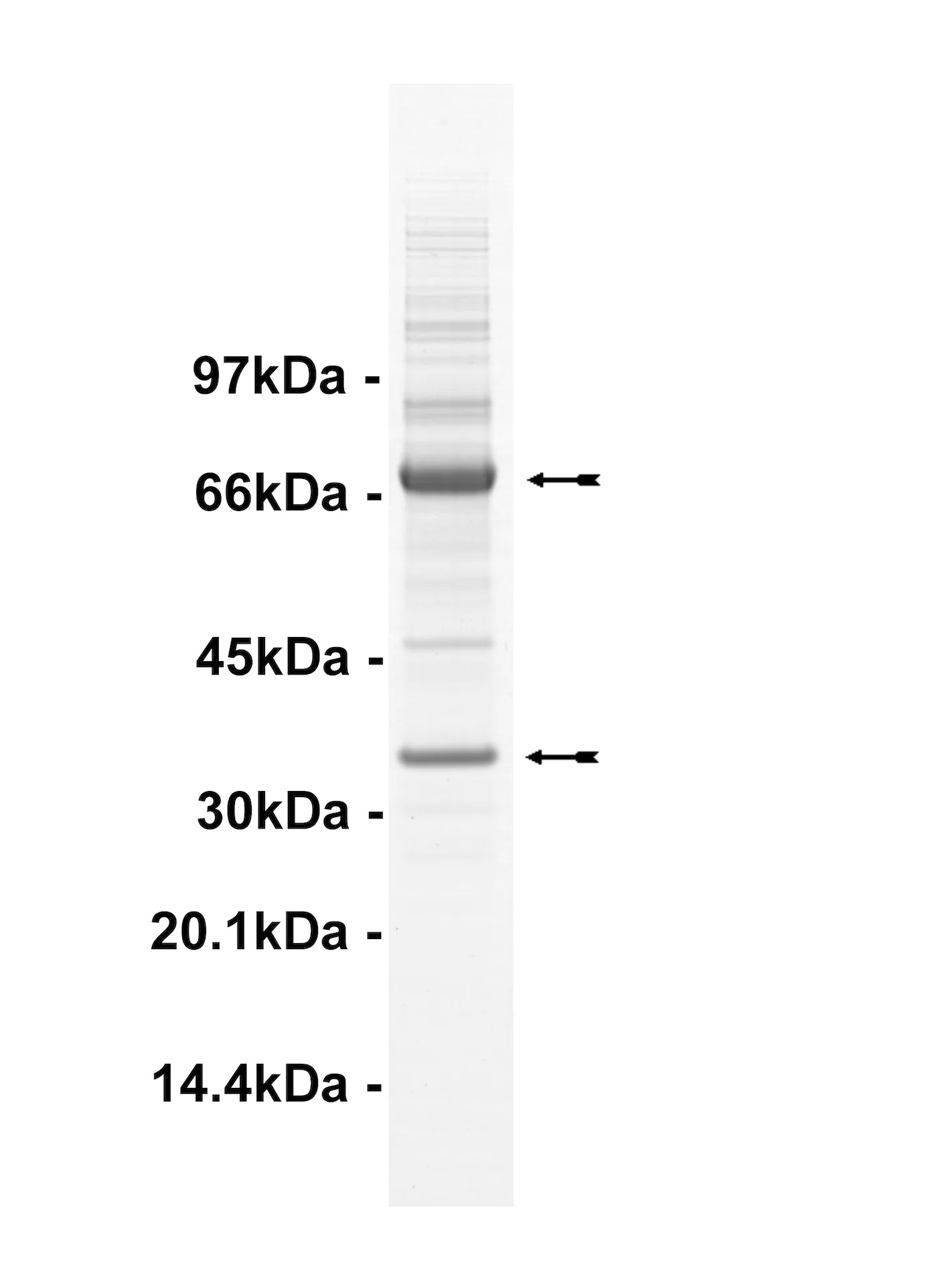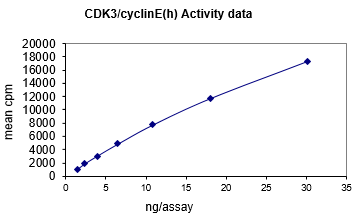Cdk3/Cyclin E, active Human Recombinant Kinase Protein
Complex of recombinant, human full length cdk3 containing a C-terminal 6His-tag, and recombinant, human full length cyclin E containing an N-terminal GST-tag.
Biological information
Background
The cyclin-dependent kinases (CDKs), a subfamily of protein kinases, promote cell cycle progression. In mammals, nine different CDKs (cdk 1 to cdk 9; cdk 1 is better known as cdc 2) have been identified. CDKs are regulated on various levels including binding of proteins (cyclins, inhibitors, and assembly factors), protein degradation, transcriptional control, localization, and multiple phosphorylations. This leads to timely regulation of CDK activity, allowing progression from one cell cycle phase to the next. Cdk3 participates in the G1–S progression at least partially by binding to E2F-1, E2F-2, or E2F-3 through DP-1 and by enhancing their transcriptional activities.
GenBank X66357 / GenBank NM_001238
Target class
Kinase
Family
CMGC
Accession number
NM_001258.1
Target Name
Cdk3/Cyclin E, active Human Recombinant Kinase Protein
Target Alias
CDK3
Origin
Human
Theori. MW
36 kDa (cdk3), 74 kDa (cyclin E)
Affinity tag
GST, 6His
Product specifications
Expression system
Expressed by baculovirus in Sf21 insect cells
Purity
Refer to CoA for Purity
Purification method
Ni2+/NTA-agarose
Sample Buffer
Specified activity
Refer to CoA
Application
For Research Only
Storage conditions
1 year at -70°C
Usage disclaimer
For Research Only
Chemical data
Background
The cyclin-dependent kinases (CDKs), a subfamily of protein kinases, promote cell cycle progression. In mammals, nine different CDKs (cdk 1 to cdk 9; cdk 1 is better known as cdc 2) have been identified. CDKs are regulated on various levels including binding of proteins (cyclins, inhibitors, and assembly factors), protein degradation, transcriptional control, localization, and multiple phosphorylations. This leads to timely regulation of CDK activity, allowing progression from one cell cycle phase to the next. Cdk3 participates in the G1–S progression at least partially by binding to E2F-1, E2F-2, or E2F-3 through DP-1 and by enhancing their transcriptional activities.
GenBank X66357 / GenBank NM_001238
Compound name
Kinase
Catalog number
14-487
Molecular formula
CAS
MW
Ka
Percent composition
Product specifications
Physical state
Purity (HPLC 214nm)
Retention time (RP18 HPLC)
CMC
Exact mass
Stability
For Research Only
Solubility structure
Kinase Activity Assay Biological information
Background
The cyclin-dependent kinases (CDKs), a subfamily of protein kinases, promote cell cycle progression. In mammals, nine different CDKs (cdk 1 to cdk 9; cdk 1 is better known as cdc 2) have been identified. CDKs are regulated on various levels including binding of proteins (cyclins, inhibitors, and assembly factors), protein degradation, transcriptional control, localization, and multiple phosphorylations. This leads to timely regulation of CDK activity, allowing progression from one cell cycle phase to the next. Cdk3 participates in the G1–S progression at least partially by binding to E2F-1, E2F-2, or E2F-3 through DP-1 and by enhancing their transcriptional activities.
GenBank X66357 / GenBank NM_001238
Target class
Kinase
Family
CMGC
Subfamily
Protein Name
CDK3/cyclinE
Protein Alias
CDK3
Accession Number
NM_001258.1
UniProt Number
Gene Name
Gene ID
Gene Aliases
Target Species
Human
Kinase Activity Assay Usage
Product Type
Application
Storage Conditions
1 year at -70°C
Usage disclaimer
Kinase Activity Assay Information
Assay Type
Assay Measures
Biological Information
Background
The cyclin-dependent kinases (CDKs), a subfamily of protein kinases, promote cell cycle progression. In mammals, nine different CDKs (cdk 1 to cdk 9; cdk 1 is better known as cdc 2) have been identified. CDKs are regulated on various levels including binding of proteins (cyclins, inhibitors, and assembly factors), protein degradation, transcriptional control, localization, and multiple phosphorylations. This leads to timely regulation of CDK activity, allowing progression from one cell cycle phase to the next. Cdk3 participates in the G1–S progression at least partially by binding to E2F-1, E2F-2, or E2F-3 through DP-1 and by enhancing their transcriptional activities.
GenBank X66357 / GenBank NM_001238
Target class
Kinase
Family
CMGC
Accession Number
NM_001258.1
Target Name
CDK3/cyclinE
Target Alias
CDK3
Origin
Human
Theoretical MW
Affinity Tag
GST, 6His
Product Specifications
Expression system
Expressed by baculovirus in Sf21 insect cells
Purity
Refer to CoA for Purity
Purification method
Ni2+/NTA-agarose
Sample Buffer
Specified activity
Refer to CoA
Application
Storage conditions
1 year at -70°C
Usage disclaimer
For Research Only
Biological Information
Background
The cyclin-dependent kinases (CDKs), a subfamily of protein kinases, promote cell cycle progression. In mammals, nine different CDKs (cdk 1 to cdk 9; cdk 1 is better known as cdc 2) have been identified. CDKs are regulated on various levels including binding of proteins (cyclins, inhibitors, and assembly factors), protein degradation, transcriptional control, localization, and multiple phosphorylations. This leads to timely regulation of CDK activity, allowing progression from one cell cycle phase to the next. Cdk3 participates in the G1–S progression at least partially by binding to E2F-1, E2F-2, or E2F-3 through DP-1 and by enhancing their transcriptional activities.
GenBank X66357 / GenBank NM_001238
Target class
Kinase
Family
CMGC
Accession Number
NM_001258.1
Target Name
CDK3/cyclinE
Target Alias
CDK3
Origin
Human
Theoretical MW
Affinity Tag
GST, 6His
Product Specifications
Expression system
Expressed by baculovirus in Sf21 insect cells
Purity
Refer to CoA for Purity
Purification method
Ni2+/NTA-agarose
Sample Buffer
Specified activity
Refer to CoA
Application
Storage conditions
1 year at -70°C
Usage disclaimer
For Research Only





